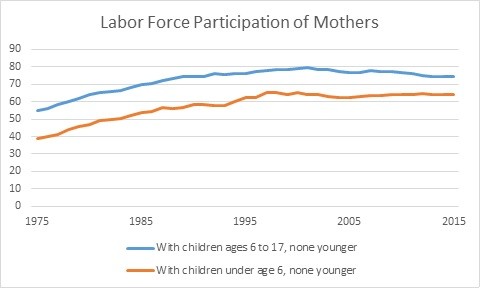There are two narratives about the labor force participation rates of mothers. The first argues that participation rates are low because women voluntarily choose to cut down on hours worked or quit their jobs after the birth of a child—the so called “opt-out” moms. The second narrative contends that the decline in participation after the birth of a child is involuntary and driven by factors such as high childcare costs and a lack of policies—such as paid family leave–that ease participation in the labor force. Clearly, the former is not a source of worry but the latter suggests that there is room for significant improvement. …
According to BLS data for 2015, of all working mothers, 76% work full-time and 24% work part-time. Working single mothers were marginally more likely to work full-time than married mothers. But what about preferences? A 2012 Pew survey found that 22% of non-working mothers would like to work full-time. Among working mothers, the demand for full-time work increased as well between 2007 and 2012. About 50% said part-time work would be ideal, down from 60% in 2007, suggesting that the recession and subsequent loss of incomes is driving some of these choices. …
It’s time to stop debating whether mothers want to work or even whether it’s ok for mothers to work. As we see in the data, that choice is obvious. The larger question is how we can make it happen in a manner that improves economic outcomes and well-being for mothers and their families. That is the discussion worth having.
Read more about mothers’ labor force participation rates and policies to get women who want to work into the workforce.






